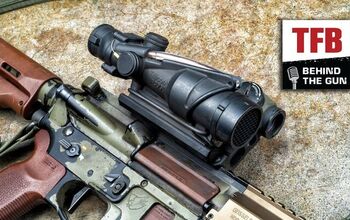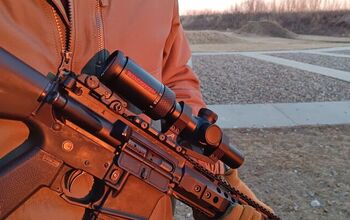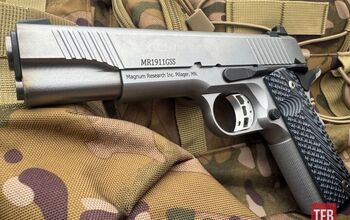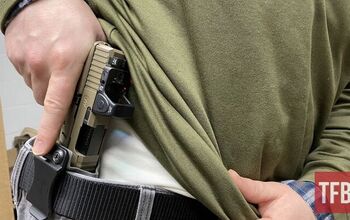The History Of The NFA: A Timeline

The National Firearms Act (NFA) of 1934 is one of the best-known American gun laws. It sets limits on some of the most interesting kinds of firearms, like machine guns. Let’s take a trip through the history of this law and where it may be headed.
NFA @ TFB:
- SILENCER SATURDAY #333: 'If Money Was No Object' – NFA Grail Guns
- New DeLisle Carbines Coming From US Armament Manufacturing
- POTD: NFA Stamp Collection
- ATF NFA Marking Requirements: Get. It. Right.
- Silencer Saturday #369: ATF Silencer Industry Data
1920s: Gangster Era
Criminals like John Dillinger and Pretty Boy Floyd used automatic firearms in their crime sprees. Local police were outgunned, and there was legislative interest in controlling access to the types of guns popular with these criminals.
1934: NFA Takes Effect
The National Firearms Act is passed and becomes law. It includes five classifications for restricted firearms:
- Short Barrel Shotguns, shoulder-fired smoothbore guns with barrels less than 18 inches
- Short Barrel Rifles, shoulder-fired rifled guns with barrels less than 18 inches
- Machine Guns, capable of firing multiple rounds with a single function of the trigger
- Silencers, any device that reduces the sound of a gunshot
- Any Other Weapon, guns that do not fit other categories
These weapons all required a $200 tax stamp. At the time, this law was enforced by the Treasury. That $200 stamp was a major cost barrier, as that would be $4,800 when corrected into 2025 dollars. AOWs like the Ithaca Auto & Burgler were seen as more legitimate, and only had a $5 tax stamp for transfers.
You may notice that short barrel rifles were those with barrels shorter than 18 inches. That is not a typo!
1936: Slight Tweak To NFA
The 18-inch barrel limit for short barrel rifles gained an exception for .22 rifles, which could have a 16-inch barrel without requiring registration. Many youth-model rimfires had barrels shorter than 18 inches, but were also not being used in many crimes. The 18-inch minimum remained in place for centerfire rifles, though.
1968: Gun Control Act
One little-known part of the GCA was changing the limit for all short barrel rifles from 18 inches down to 16 inches. Several factors played into this. One is that many lever action rifles had 16-inch barrels, particularly among trapper and saddle rifles. But the major impetus was the M1 Carbine. These guns, with 16.25-inch barrels, were sold in large numbers to NRA members. 240,000 M1 Carbines were sold in 1963 through the program for only $20 each. While these sales obviously had governmental approval because they went from US Army stockpiles to the NRA membership, each of those guns was technically an SBR, though they were not registered as such. The 1968 GCA fixed that situation.
1986: Firearm Owners’ Protection Act
The FOPA added various legal protections for gun owners, including the right to drive through states with more restrictive gun laws so long as they did not stay there longer than necessary. FOPA also added language that made silencer parts subject to the NFA. But the main change was the ban on registering new machine guns for transfer to civilians. Those automatic firearms already registered prior to May of 1986 could still be kept or transferred to other civilians, but no more could be registered.
This has led to massive increases in machine gun prices over the years. Just check out these charts of how the prices have changed. Even the MAC10, long known for being a “cheap” machine gun, is now selling on average for more than $13,000. Of course, this price inflation has not impacted guns sold to military or law enforcement, and 07/02 dealers can make their own machine guns, though they still cannot sell them to consumers.
2016: ATF Rule 41F
This rule is most remembered for the way that it changed owning NFA items through trusts. 41F requires all “responsible persons,” generally the trustees of the trust, to file fingerprints and passport photos for a background check. This led to more paperwork when buying NFA items but still kept the benefits of having multiple trustees have access to the NFA item.
One other change made by Rule 41F was around notification to the local chief law enforcement officer. Prior to 41F, individual purchasers had to obtain permission from the chief law enforcement officer (sheriff or chief of police) where they lived. This rule changed from affirmative permission to simple notification, but also applied to NFA items owned by trusts, not just individuals. This helped buyers in cities and counties where law enforcement would not previously authorize any NFA transfers.
2017: Hearing Protection Act
The HPA was an effort to remove silencers from the NFA entirely. It ultimately failed to pass. It has been reintroduced several times but met with the same fate each time. The HPA would remove silencers entirely from the NFA.
2025: Big Beautiful Bill
The most recent big news in the NFA world is the current Big Beautiful Bill. Along with all sorts of other provisions, this bill also includes two provisions that touch on the NFA. This bill has gone through several iterations, but as of the writing of this piece, it includes a version of the Hearing Protection Act as well as a tax change. The HPA provisions would entirely remove silencers from the NFA. How silencers would be regulated if this were to pass would depend on individual state laws.
Another provision in the bill would drop the tax stamp amount from $200 to $0. All other NFA protections would remain in place, and the other tax stamps would stay at the current amounts. Putting both of these changes into the bill is not necessarily a conflict. And in the “sausage making” of a bill becoming a law, one portion could be dropped without losing all progress on silencers.
Conclusion
The Big Beautiful Bill still has to move through the Senate before it becomes law. Much like a jury trial, anything is possible while a bill file is in play, and no one should count their legislative chickens until they have hatched. But if either of these changes to silencer regulation actually makes it through, expect to see a major run on silencers and everything to be out of stock. We’ll be monitoring the Bill’s progress and will bring you guys the latest.

AKA @fromtheguncounter on Instagram. Gun nerd, reloader, attorney, and mediocre hunter.
More by Daniel Y
















![[SHOT 2025] H&R Lever Guns, DOE Subgun](https://cdn-fastly.thefirearmblog.com/media/2025/01/22/10151/shot-2025-h-r-lever-guns-doe-subgun.jpg?size=350x220)



![[SHOT 2025] Carbon Research Introduces New Big Bore Suppressor](https://cdn-fastly.thefirearmblog.com/media/2025/01/30/13391/shot-2025-carbon-research-introduces-new-big-bore-suppressor.jpg?size=350x220)






Comments
Join the conversation
The Byrd Rule may become an issue when the Senate takes up this bill.
Unfortunately, if the tax is reduced to $0, suppressors are going to be continue to be regulated until the NFA is repealed or struck down. And with inflation, $200 isn't the issue, the paperwork and registration is.